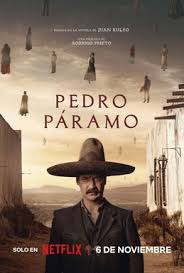
PEDRO PARAMO
Mexico, 2024, 130 minutes, Colour.
Manuel Garcia-Rulfo, Tenoch Huerta, Dolores Heredia, Ilse Salas, Mayra Batalla, Roberto Sosa.
Directed by Rodrigo Prieto.
Background: in this Mexican film is based on the celebrated novel, published in 1955, by Juan Rulfo. It is credited with offering cultural and religious background in Mexican history and, in the literary world, introducing the style of “magic realism”. While it has an introductory narrative, the novel and the film moves between the real world and an imaginary world, spirits, ghostly presences, there are flashbacks to an actual past combined with the consequences in the real world and in the spirit world. There is a Catholic background, represented by an obsessive priest, but also pre-Christian beliefs about death, heaven and hell, the after-world, of the spirits of the dead roaming the world.
This film version was written by Spanish writer, Matteo Gil. It has been directed by cinematographer, Rodrigo Prieto, his first feature film, a favoured cinematographer by Mexican directors as well as for several films by Martin Scorsese – and Barbie!
Here, the cinematography is evocative, vast arid Mexican plains, the remains of the ghost city, vibrant and colourful flashbacks of life when the city prospered, and many dark sequences, strange presences, death experiences, ghostly communications.
The film opens with a man coming to the town where he was born, at the behest of his mother, to meet his father, make claims from him, understand him. However, his father is dead. And, in the town, many strange characters, women who had encountered his father, his father’s devoted housekeeper, some of his father’s wives and women. And the question is whether the man himself, with his experience in the town, is now dead and is part of this unearthly community.
The book and the film provide many challenges to readers and viewers, to identify the particular characters, especially the father, seeing him as a very young man, middle-aged, older, finding their place in the town, in relationships.
The time setting th ranges from the end of e 19th-century, era of wealthy landowners, patriarchy, exploitative of women, ignoring children, arrogant presuppositions of superiority to the Mexican revolutions of the 1910s. And the role of the church, religious traditions, funerals, confessions, and strange theological expressions.
The film was well received, comparisons naturally made with the novel, but the film is an interpretation of the novel and they are not to be equated.
- The original novel, its worlds, the real world, the spirit world, the history of Mexico, the late 19th century, early 20th century, patriarchy, exploitation, the revolutions of the 1910s?
- The adaptation of the novel, structure, characters, its variety of worlds, and novel texts and speeches becoming part of the screenplay?
- The landscapes, the opening, mountains plains, desert, the abandoned town, the wrecked buildings, the dark streets? The dark atmosphere, characters appearing and disappearing? Juan and his journey, whether he was dead or alive?
- The contrast between the ghostly abandoned town and the flashbacks, prosperity, farms, the landowner, the workers, the foreman?
- Pedro, the title, talk about him, audience attitudes, Juan’s mother and her leaving, the encounter with the man, his being one of Pedro’s sons (and his later appearance to plead for money for the burial of h and is wife and his being rejected, killed)?
- The role of women in the film, the dead mother and her history, the marriage, her period and suggesting her friend substitute for her with the husband, her pregnancy, the birth, departure? Susanna, as a girl, flirtatious with Pedro, her having to leave, looking back, her later return, the black-and-white pool sequences, the relationship, her illness, Pedro and his attentions? The role of the priest and his interventions, especially as she was dying, the experience of her death? The mother’s friend, still in the town, offering hospitality to Juan, her stories, especially about his mother? Her disappearance?
- Damiana, her appearance, guiding Juan, the flashbacks, the significance of her role in the household, housekeeping, advice, with Pedro, with the other women, serving them? Her influence on Juan?
- The woman in black, hunched, observing, on the outer, needing food, her interventions, her guiding Juan? The forceful character?
- The presence of the priest, his attitudes, the deaths of his relatives, the blaming of Pedro, the funeral of the son, his initial refusal to pray, the sprinkling of the holy water? His utterances, theological, life and death? The confession sequences? His continued presence, rituals, his presence at Susanna’s death, the weirdness of his prayer, incorporating traditions and superstitions, earth and the mouth, the nature of sin and corruption, possibilities of forgiveness or not, hell and heaven? The revolutionaries, arrival, Motley again, threats to Pedro, the table, checking the leaders, offering the money, the bargain, the consequences?
- The portrait of Pedro, as a wilful young man, his wealth, his father, the women, the story of his son, his son and his exploitative behaviour, his death, the funeral? His foreman and the work, on the property, the workers? His prosperity, the socials, his wives, his behaviour, Susanna’s return and its effect on him? The visit of the revolutionaries, his sitting with them, offering his help, the foreman, the killing him and leaving him in the flowing water?
- Time passing, changing Mexican society, the challenge to the patriarchy and the landowners, Pedro and the death of Susana, his grief, his sitting in the chair, growing older? The final challenge, the attack on him, on Damiana, their deaths?
- The impact of this film for Mexican audiences and their knowledge of the novel? On Spanish-speaking audiences? On world audiences and their being invited into this very different world?